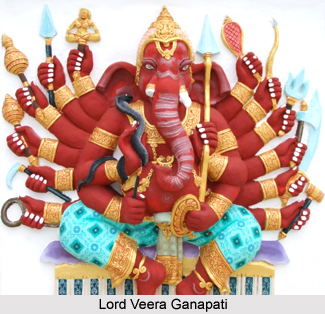 Veera Ganapati refers to the valorous warrior. This is one of the popular forms of Lord Ganesha. In this form, He is depicted with red complexion and His face has a serious look. Veera Ganapati has eight arms with which He holds a trident, a battle-axe, a pick-axe, a noose, a goad, a mace or gada, a hammer, a sword, a bow and arrow, a shield, a discus (chakra), a vethal or goblin, a spear, a serpent and banner.
Veera Ganapati refers to the valorous warrior. This is one of the popular forms of Lord Ganesha. In this form, He is depicted with red complexion and His face has a serious look. Veera Ganapati has eight arms with which He holds a trident, a battle-axe, a pick-axe, a noose, a goad, a mace or gada, a hammer, a sword, a bow and arrow, a shield, a discus (chakra), a vethal or goblin, a spear, a serpent and banner.
The Veera Ganapati form represents the element of Agni (Fire). The devotees of Lord Ganesha worship this form to defeat fear and gain courage in order to face complicated circumstances and also eliminate wickedness and ignorance. The temples of Veera Ganapati are Arulmigu Meenakshi Sundareswarar Temple in Madurai, Tamil Nadu and the temples in Chamarajanagar and Nanjangud in Mysore, Karnataka.
The worshippers of the Lord worship this form by reciting the Veera Ganapati Mantra. This is mentioned as follows-
Vetala Shakti Shara Karumuka Chakra Kanga
Khadanga, Mudgara Gadaakusha Nagapasham
Shoolam Cha Kunta Parashu, Dhvajakudhvahantam
Veeram Ganeshamarunam, Satatam Smarami.
This article is a stub. You may enrich it by adding more information to it. You can send your write-up at content@indianetzone.com




















